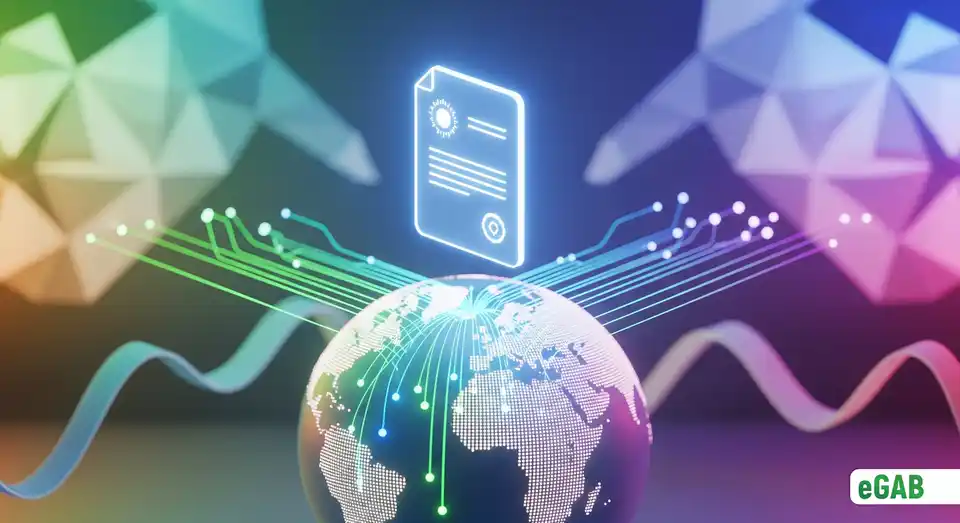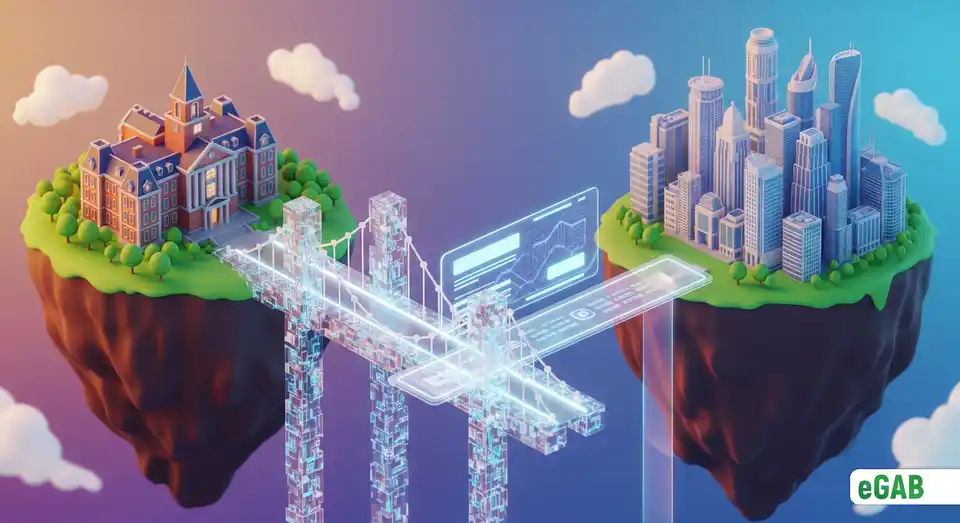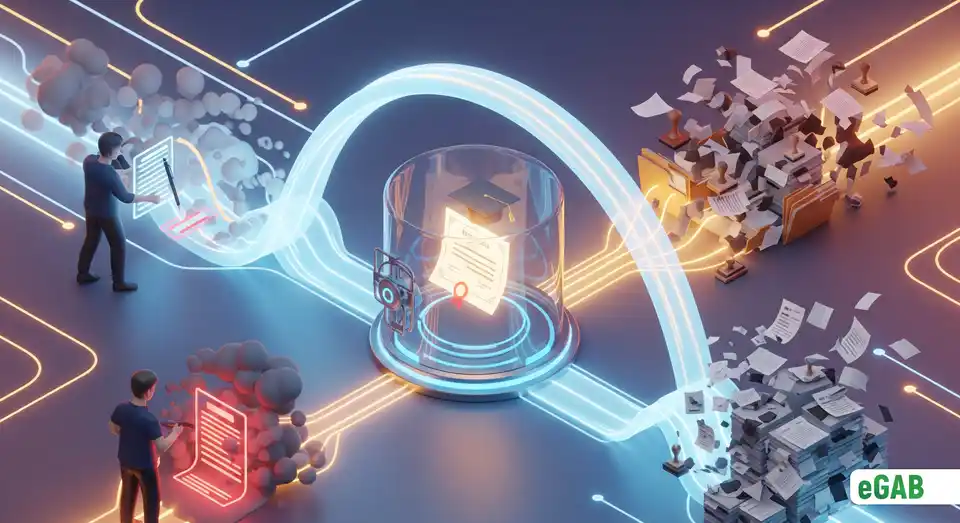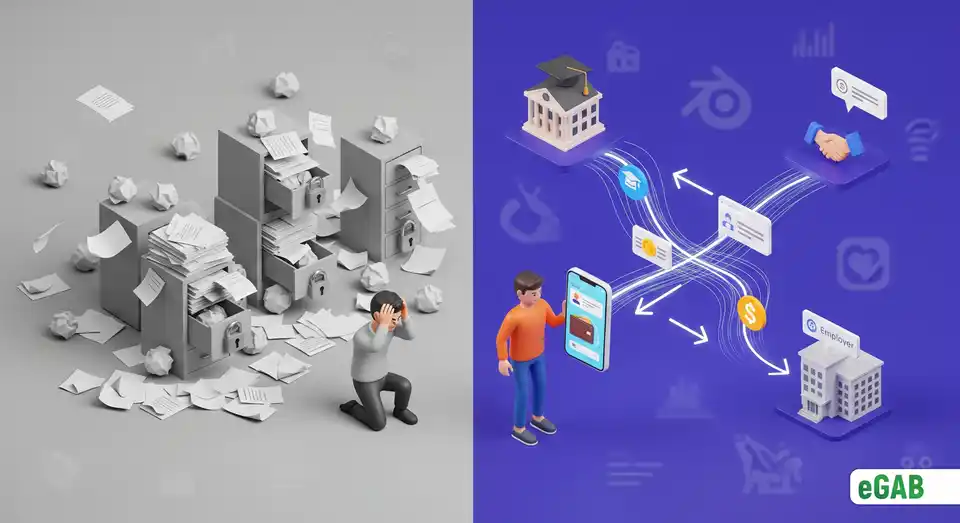The Global Digital Document Exchange Program Definition, Principles, and Purpose

 Author:
Artem Grigoriev
Author:
Artem Grigoriev
We live in a world of instant global payments and communication. So, isn't it strange that your most valuable professional assets are often stuck in the last century? I'm talking about your academic and professional credentials. You've invested years of hard work to earn your qualifications, yet proving they're authentic across borders can be a complete nightmare. It forces you to navigate a slow, frustrating, and insecure maze of paperwork.
This is the exact problem The Global Digital Credentials Management Program was created to solve. It finally closes the gap between our digital world and the need for lifelong learning , directly shaping the future of digital documents.
So, what is it exactly? It’s a strategic framework that establishes a single, secure environment for trusted and instantly verifiable credentials .
This guide will break it all down for you. We’ll explore its core definition, its fundamental principles, and the rules that guarantee its integrity. We'll also show you the vital purpose it serves-creating a world where your achievements are recognized instantly, without borders or doubt.
📘 This post is part of our comprehensive guide to "The Global Digital Credentials Management Program". Explore it to find answers to all your questions ;)
Definition: What is The Global Digital Credentials Management Program?
In a world that’s more connected than ever, why are your academic achievements stuck in the past? It’s a frustrating question. You live in an age of instant global communication, yet your diplomas and certificates are often still paper-based, slow to verify, and worse, they're trapped within the walls of the schools that issued them. These are the exact, critical problems of paper and digital documents that "The Global Digital Credentials Management Program for Educational Credentials" was built to solve.
At its heart, this program is a strategic plan to create a single, secure, and efficient environment for your digital academic credentials. But it’s about much more than just turning a paper certificate into a PDF; it actually covers the entire lifecycle of a credential. This starts from the moment it’s issued and stored and continues to how it's seamlessly shared and verified across the globe. The core challenge here is that our current systems are hopelessly fragmented and visibly struggling. They can't keep up with the demands of a globalized workforce, and they also can't meet the modern, pressing need for lifelong learning . Let's be honest, this isn't a new problem, as major organizations like the OECD have highlighted this growing gap in reports on the future of education .
So, what’s the big idea? The program’s ambitious goal is to build a common framework that successfully transcends geographical and institutional boundaries . The result is a truly global ecosystem for academic and professional recognition. Think of this less as a simple tech upgrade and more of a fundamental paradigm shift . We are consciously moving away from countless incompatible, local systems and steering toward a harmonized global space -a place where your digital academic achievements are instantly recognized and trusted.
This innovative new approach is all about empowering individuals , giving you true, sovereign control over your own verified achievements. This is a core principle passionately championed by the MyData Global movement , which advocates for a more human-centric way to manage personal data. By using technologies that support verifiable claims, the program also gets to work helping reduce the information asymmetry (in simple terms, an imbalance of information) that currently exists between schools, the people who hold credentials, and the employers who need to verify them. The ultimate result is a game-changer: the seamless cross-border recognition of qualifications. This makes it significantly easier for you to pursue exciting opportunities anywhere in the world.
While the old, outdated model chained your credentials to a specific institution, making any verification process slow and incredibly cumbersome, this new program gives you a universal "digital passport" for your achievements-one that’s instantly trusted and recognized everywhere you go.

The 6 Core Principles of the Program
For a global system this large to work, it needs a rock-solid foundation based on twelve core principles; you simply can't build it on wishful thinking. That's why its entire architecture, which is made of six core components, is firmly built on these six principles. These principles guide every single decision. They also ensure the program is robust, reliable, and truly ready for the real world.
The first and most important of these is globality and universality . What does that actually mean? It means any solution developed under the program has to work everywhere and must be recognized worldwide . Your credentials should never lose their value just because you cross a border. This vision aligns perfectly with major international efforts, like the UNESCO Global Convention on the Recognition of Qualifications concerning Higher Education -a group that’s dedicated to creating fair ways to recognize qualifications, regardless of what country or school they're from.
Of course, global recognition is meaningless without security and trust . This second principle is completely non-negotiable. The program's top priorities are clear: we must protect user data, and we must prevent fraud at every single turn. This approach builds unconditional trust in digital documents. To do this, we use powerful cryptographic techniques, many of which are at the heart of blockchain technology. This includes using public-key cryptography (think of it as a unique digital key that you use to sign and verify your documents). The system also uses hash functions to meticulously guarantee your data's integrity.
A system that's secure but slow and complicated helps no one. That's exactly why the third principle is efficiency and simplicity . Every single process, from issuing and managing to verifying documents, must be simple, automated, and as economically viable as possible. The goal here is a big one: we want to shrink the time it takes to verify your qualifications from weeks to mere seconds .
This focus on a smooth experience leads to our fourth principle: user-centricity . At the end of the day, technology is for people. All solutions have to be convenient and accessible, ...clearly showing who benefits from digital documents-whether you're a student, a graduate, or a hiring manager. This means building intuitive interfaces and following modern accessibility standards like WCAG. Most importantly, it means giving you easy access to and control over your own credentials .
To make this seamless experience possible, all parts of the system must speak the same language. This is the core idea behind interoperability and standardization . We must avoid creating a new generation of digital silos that trap valuable data. By using common data formats like JSON-LD , we create a universal translator that allows different platforms to communicate and understand each other flawlessly.
Finally, none of this can exist in a legal vacuum. The sixth principle, legal compliance , ensures the program follows all relevant laws. This covers national and international rules, complex education regulations, and data protection laws like GDPR in Europe and FERPA in the US. Of course, it also applies to digital assets. This means we tackle challenging issues like data sovereignty and cross-border data flows head-on. We also work to ensure the legal recognition of digital signatures everywhere.
These six principles are much more than just a technical checklist; they are a solemn promise. They guarantee that your digital credentials will be global and secure. They will also be fast, user-friendly, universally compatible, and legally sound. This is the ultimate blueprint for a system built on a rock-solid foundation of trust.

Purpose: Why This Program is Essential
To really understand this program's value, which is guided by six key objectives, you have to look at the deep-seated problems it was built to solve. This isn't just another technology upgrade; it's a direct response to the glaring inefficiencies and risks that plague our current systems. When you peel back the layers of how things work now, you find a system that’s not only frustratingly slow but also profoundly insecure. Ultimately, it’s a system that's holding us all back.
First and foremost, this program is a powerful tool designed to combat fraud and forgery . Let’s be honest: traditional paper diplomas and their basic PDF copies are shockingly easy to fake. This reality doesn't just devalue legitimate qualifications; it undermines the very integrity of our entire education system. More than that, it creates significant risks for employers , who could unknowingly hire unqualified people for critical roles. The solution is the program's use of advanced cryptographic technologies, like those in The Global Academic Blockchain (eGAB). This technology makes credentials tamper-evident . In simple terms, this means every digital certificate becomes immutable and can’t be altered in any way after it's issued. As a result, its authenticity can be verified in seconds, not weeks, which delivers a level of trust that’s simply impossible with paper.
Beyond security, the program works hard to eliminate the significant barriers to international verification . Have you ever tried to get a foreign degree officially recognized? If so, you know the pain. The process is a notoriously slow, expensive, and bureaucratic nightmare, often involving tedious official requests, costly international shipping, and complex legal procedures like apostilles . All this administrative friction is a major roadblock to seamless global mobility for students and professionals. By creating a globally interoperable verification network , the program tears down these frustrating obstacles. This network lets any authorized party-whether a university admissions office or a corporate hiring manager-validate a credential’s authenticity instantly online, from anywhere in the world. With this system, the administrative friction just melts away.
This benefit leads directly to another one of the program's core purposes: to reduce administrative burden and associated costs . Right now, educational institutions spend a fortune on things like secure printing, extensive physical archiving, and all the manual labor needed to handle verification requests. These significant overheads divert precious resources away from the real mission of education. By driving automation and efficiency , the program completely changes this financial equation. Here's the bottom line: for many tasks, digital issuance and instant verification can slash administrative overhead by an impressive up to 70% . That’s money and manpower these institutions can then reinvest where it truly matters: back into teaching, student innovation, and vital research.
Finally, the program is absolutely essential to establish universal standards for interoperability . The current credentialing world is a chaotic patchwork of incompatible and proprietary systems. This widespread fragmentation creates countless data silos , making it impossible for critical information to flow smoothly between different schools, systems, and countries. To fix this, the program champions the adoption of common, open standards . A great example is the powerful W3C Verifiable Credentials Data Model . Think of it as a universal language that all these different systems can use to speak to each other. By making sure different platforms can communicate, we can finally build a truly connected global ecosystem for both education and employment.
At its heart, this program isn't just about digitizing old processes; it's about building a rock-solid foundation of trust. For you, this means your achievements are secure, totally portable, and you can prove them instantly anywhere in the world. For employers and institutions, that means dramatically lower risk and a huge reduction in administrative waste. Ultimately, it’s a major shift toward creating a more honest and efficient world for all of us.

Summary: A New Paradigm for Educational Credentials
When you take a step back and look at the whole picture, it’s clear that The Global Digital Credentials Management Program is so much more than a simple tech update. It’s a fundamental solution to the deep-rooted problems of traditional credentialing. The old way has been slow, insecure, and incredibly frustrating for everyone. For too long, our academic achievements have been locked away in fragmented systems that just can't keep up with our connected, mobile world. The result? A serious lack of trust in academic qualifications .
This program systematically tears down that old, broken framework. It replaces it with a new one built on a solid foundation of six core principles. Through globality and universality , the main goal is to create a single, borderless system that ensures your achievements are valued everywhere you go. A strong commitment to interoperability and standardization makes this happen by allowing different systems to talk to each other seamlessly. At its heart, the program is built on security and trust , using powerful cryptographic technology to make fraud virtually impossible. This secure environment is also designed for efficiency and simplicity , as it automates slow, manual processes and saves everyone time and money. Crucially, it’s a user-centric model. This modern approach puts you in control of your own data while ensuring strict legal compliance with global data protection standards.
Basically, this initiative strategically replaces an outdated model. It swaps an untrustworthy system for one that's secure, efficient, and globally recognized . It’s the essential groundwork for a future we can all believe in-a future where your hard-earned achievements can be verified instantly, without borders and without a shadow of a doubt. By doing this, it creates a more honest and efficient ecosystem . This new environment is built to deliver huge value to students, schools, and employers across the globe.
➡️ Next up: This article introduced the program's principles. To fully appreciate the framework's integrity, it's essential to understand each one in detail. Delve into the 12 foundational principles of the GDCP.

The 6 Core Components of the GDCP Ecosystem
The Future of Digital Credentials: AI, Micro-Credentials, and the GDCP
Who Benefits from Digital Credentials? The GDCP Advantage
The 12 Foundational Principles of the GDCP
The 6 Core Objectives of the GDCP Program
